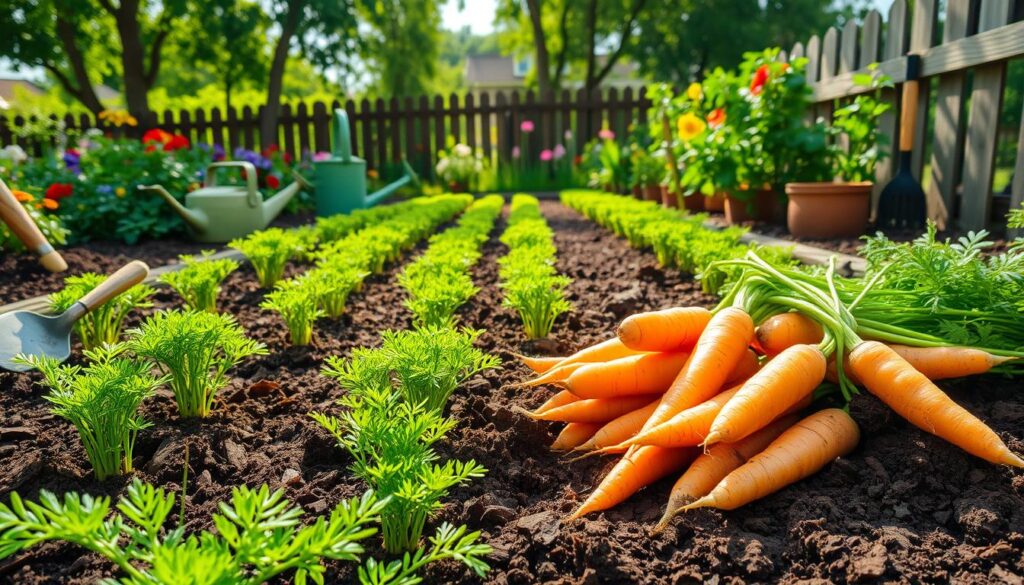Welcome to our guide on How to Grow Carrots. Growing carrots at home can be very rewarding. With the right tips, you can enjoy a harvest of crunchy, flavorful carrots.
This guide is for both seasoned gardeners and beginners. We’ll cover everything from understanding varieties to harvesting and storing carrots. We aim to help you grow carrots successfully.
We want to help you grow delicious, healthy carrots at home. Our guide will teach you the best tips for a successful harvest.
Introduction to Carrot Growing
In this guide, we’ll cover all you need to know about growing carrots. From basic tips to advanced techniques, we’ve got you covered.
Key Takeaways
- Learn the best Carrot Growing Tips for a successful harvest
- Understand the different varieties of carrots and their growing requirements
- Discover the essential tools and materials needed for growing carrots
- Learn How to Grow Carrots with our step-by-step planting guide
- Get tips on How to Grow Carrots in containers and small spaces
- Understand the importance of proper soil management and maintenance
- Learn how to troubleshoot common growing problems and achieve a bountiful harvest
Understanding Carrot Varieties and Their Growing Requirements
Planting carrots requires knowing the different types and what they need to grow well. There are many varieties, like Nantes, Imperator, and Danver. Each has its own size, shape, color, and taste. It’s important to give your chosen variety the best growing conditions.
Carrot care starts with picking the right variety for your garden. Some favorites for home gardens are:
- Nantes carrots, known for their sweet flavor and crunchy texture
- Imperator carrots, recognized for their long, slender shape and high yield
- Danver carrots, prized for their robust flavor and resistance to disease
When planting carrots, think about the climate and season. Carrots do best in cooler weather and well-draining soil. This makes spring or fall gardens perfect for them. By knowing what your variety needs, you can grow a healthy crop.
Carrots need full sun, well-draining soil, and enough water. With the right care, you’ll get a tasty and healthy crop. Whether you’re new to gardening or have experience, growing carrots can be very rewarding.
Preparing Your Soil for Carrot Growth
Preparing the soil is key when Growing Vegetables at Home. Carrots need well-draining, loose soil that’s rich in organic matter. To get this, add compost or well-rotted manure to improve the soil’s structure and fertility.
Here are some tips for soil preparation:
- Remove debris, rocks, and weeds that can harm carrot growth.
- Add a 2-inch layer of compost or well-rotted manure to the soil.
- Mix the compost or manure into the soil to a depth of 8-10 inches.
By following these steps, you can create the perfect soil for Growing Vegetables at Home, like carrots.
Remember, the secret to growing great carrots is in the soil preparation. By preparing your soil well, you’ll get a healthy and productive harvest.
| Soil Preparation Step | Description |
|---|---|
| Remove debris and rocks | Clear the soil of any debris, rocks, or weeds that can interfere with carrot growth |
| Add compost or manure | Add a 2-inch layer of compost or well-rotted manure to the soil to improve its structure and fertility |
| Mix the compost or manure | Mix the compost or manure into the soil to a depth of 8-10 inches |
Essential Tools and Materials for Growing Carrots
To start with Organic Carrot Gardening, you need some key tools and materials. They help you get the soil ready, plant the seeds, and care for your garden. The right tools are vital for a successful carrot crop.
Basic Gardening Tools Needed
You’ll need a shovel, rake, and hoe for soil prep and planting. A garden fork is also useful. It helps loosen the soil and removes debris.
Soil Amendments and Fertilizers
Soil amendments and fertilizers, like compost and organic fertilizers, boost soil health. They’re key for Organic Carrot Gardening. They naturally improve the soil for healthy carrot growth.
Garden Planning Materials
For garden planning, you’ll need a garden plan and a planting calendar. These tools help you organize your garden. They guide you on planting times, spacing, and harvest.
How to Grow Carrots: Step-by-Step Planting Guide
Growing carrots needs a good plan for a great harvest. Harvesting Carrots is rewarding but requires careful planting. Start by loosening your soil to 12 inches deep. This helps carrots grow without problems.
Spacing and depth are critical for carrots. Here’s what to remember:
- Plant seeds ¼ inch deep and ¼ inch apart.
- Thin them to 1-2 inches apart as they grow.
- Keep the soil moist but not too wet for healthy growth.
By following these steps and giving carrots the right conditions, you’ll have a great harvest. Make sure to keep the soil moist and ask for help if needed.
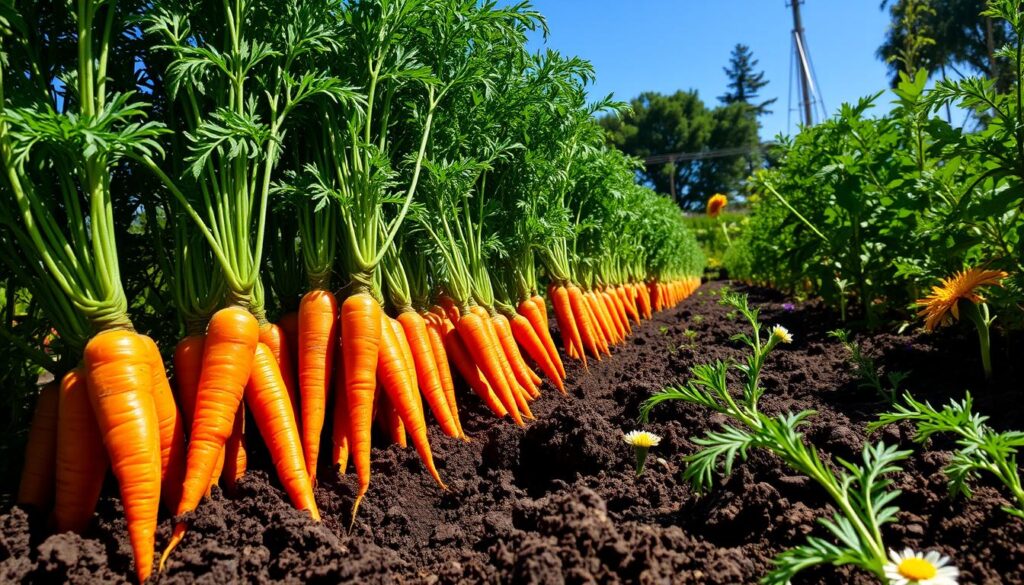
Carrots are usually ready in 60-70 days. Check them often to know when to harvest. With proper care, you’ll enjoy fresh, crunchy carrots soon.
| Carrot Variety | Days to Maturity | Harvesting Method |
|---|---|---|
| Little Finger | 60 | Hand-pull |
| Danver | 70 | Fork-lift |
Proper Spacing and Depth Requirements
Carrot Plant Care requires the right spacing and depth for healthy growth. It’s important to give carrots enough room to grow well. This means following guidelines for row spacing and thinning to avoid overcrowding.
Here are some tips for growing carrots:
- Plant carrot seeds ¼ inch deep and ¼ inch apart in rows that are 1-2 feet apart.
- Once the seedlings have emerged, thin them to 1-2 inches apart to prevent overcrowding.
Thinning is key to prevent competition for water and nutrients. Giving carrots enough space leads to a better harvest. Also, consider planting carrots with beneficial companions like sage, rosemary, and onions to improve growth and reduce pests.
Row Spacing Guidelines
Carrot variety affects spacing needs. Some, like ‘Little Finger’ or ‘Danver’s Half-Long’, need more space. Follow these guidelines to ensure your carrots have the right space for a successful harvest.
Proper Thinning Techniques
Thinning carrot seedlings is essential. It helps promote healthy growth and prevents overcrowding. This also reduces the risk of diseases and pests that thrive in crowded areas.
Watering Techniques for Healthy Carrot Growth
Watering is key when it comes to Carrot Growing Tips. Carrots need consistent moisture, which is important during germination and growth. It’s important to avoid too much or too little water, as it can harm the carrots.
Here are some tips for Planting Carrots:
- Water carrots regularly, providing about 1 inch of water per week.
- Use a soaker hose or drip irrigation to deliver water directly to the roots, reducing evaporation and runoff.
- Mulch around the plants to retain moisture and suppress weeds.
By following these Carrot Growing Tips and using the right Planting Carrots methods, you can help your carrots grow well.
Remember, keeping the soil moist and using the right watering methods are essential for growing tasty carrots. With these tips, you’ll be on your way to a great carrot harvest.
| Watering Technique | Benefits |
|---|---|
| Soaker Hose | Reduces evaporation and runoff |
| Drip Irrigation | Delivers water directly to the roots |
| Mulching | Retains moisture and suppresses weeds |
Essential Soil Management Practices
Growing Vegetables at Home, like Organic Carrot Gardening, needs good soil care. Healthy soil is key for a great carrot harvest.
To get the best soil, keep the pH right, add nutrients, and manage moisture. These steps help carrots grow well.
Maintaining Proper pH Levels
Carrots grow best in soil with a pH of 6.0 to 6.8. Use compost or manure to adjust the pH.
Nutrient Requirements
Carrots need nitrogen, phosphorus, and potassium. Organic fertilizers like fish emulsion or bone meal can help.
Soil Moisture Management
Soil moisture is very important for carrots. Keep it moist but not too wet. Mulch or cover crops help with this.
| Soil Factor | Ideal Condition |
|---|---|
| pH Level | 6.0-6.8 |
| Nutrient Balance | Nitrogen, Phosphorus, Potassium |
| Soil Moisture | Consistently moist, not waterlogged |
By managing your soil well, you can make a great place for carrots to grow. Enjoy a big harvest from your Organic Carrot Gardening.
Managing Common Carrot Pests
Carrot Care is key to fighting pests that harm your crop. When Harvesting Carrots, look for pest signs. Aphids, slugs, and snails are common pests.
To tackle these pests, try organic and integrated pest management. A healthy ecosystem can prevent infestations. Here are some tips:
- Use physical barriers to stop slugs and snails from getting to your carrots.
- Encourage beneficial insects like ladybugs and lacewings to fight aphids.
- Keep your carrot bed clean and free of debris to avoid attracting pests.
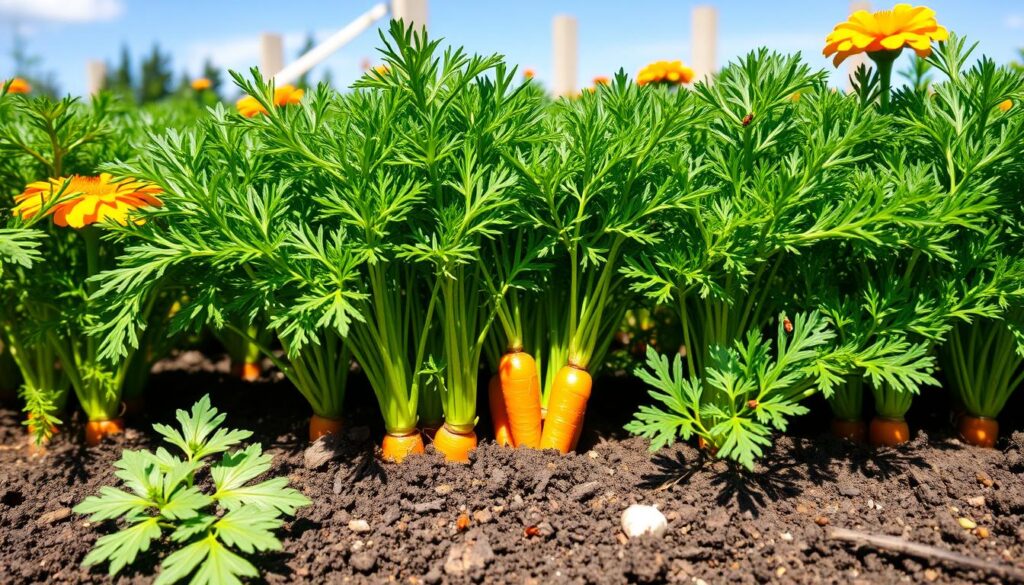
By following these tips and practicing good Carrot Care, you can avoid pests. This ensures a healthy and successful crop when Harvesting Carrots.
| Pest | Management Technique |
|---|---|
| Aphids | Encourage beneficial insects, use neem oil |
| Slugs and Snails | Use physical barriers, remove debris |
Preventing and Treating Carrot Diseases
Carrot plant care means knowing about common diseases. It’s key to keep your garden clean and well-ventilated. Check your plants often for signs of disease.
Fungal infections like powdery mildew and root rot are common. Bacterial leaf blight is another problem. To stop these, make sure your soil drains well and don’t overwater. For more tips, visit beginner’s guides to gardening.
To prevent diseases, use organic methods and grow resistant varieties. Follow these tips to keep your carrots healthy and thriving.
Common Fungal Issues
- Powdery mildew
- Root rot
Bacterial Problems
- Bacterial leaf blight
Prevention Strategies
- Regular inspection of plants
- Proper soil drainage
- Avoiding overwatering
- Using disease-resistant varieties
By being proactive, you can prevent and treat carrot diseases. This way, you’ll have a successful harvest and enjoy your carrot plant care efforts.
Organic Growing Methods for Carrots
Organic Carrot Gardening focuses on a balanced ecosystem for healthy growth. It uses natural soil amendments and fertilizers. This method benefits carrots and supports Growing Vegetables at Home sustainably.
Gardeners can use compost, manure, and green sand for organic growing. These materials enrich the soil with nutrients. They improve soil structure and fertility.
The benefits of organic growing include:
- Improved soil health and fertility
- Increased crop yields and better flavor
- Reduced environmental impact and pollution
- Enhanced biodiversity in the garden ecosystem
Organic Carrot Gardening offers rewards for Growing Vegetables at Home. It promotes a sustainable gardening approach. Gardeners work with nature, creating a balanced ecosystem for carrots and the environment.
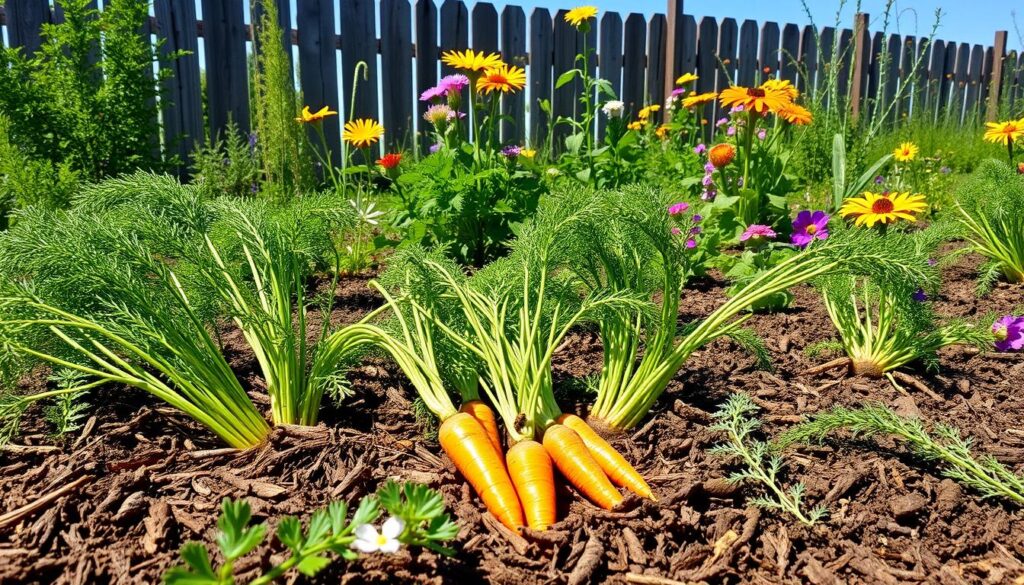
Tips for Growing Carrots in Containers
Growing carrots in containers is a great way to enjoy fresh carrots, even in small spaces. When planting carrots in containers, it’s key to pick the right container and care for them well. Here are some Carrot Growing Tips to help you start:
When picking a container, think about depth and drainage. Carrots need a deep spot with good drainage to grow right. A container that’s at least 6-8 inches deep is best. You can use a plastic or clay pot, or even a wooden planter.
It’s also important to give your container-grown carrots special care. This includes enough water, fertilizer, and sunlight. Here are some special care tips to remember:
- Water your carrots regularly, but don’t overdo it
- Use a balanced fertilizer for healthy growth
- Give them at least 6 hours of direct sunlight a day
By following these Carrot Growing Tips and caring for them right, you can enjoy a big harvest of tasty and healthy carrots. Remember to keep your container in good shape. And don’t hesitate to ask if you have any questions or concerns about Planting Carrots in containers.
When and How to Harvest Carrots
Harvesting carrots is a thrilling moment for gardeners. Knowing when and how to harvest is key for the best taste and texture. Good Carrot Plant Care is vital at this stage, as it impacts the quality of your harvest.
To see if your carrots are ready, gently dig around them with a fork. If they’re between 1/2 to 1 inch thick, they’re probably ready. Also, check their color. Most carrots turn a deeper orange as they grow.
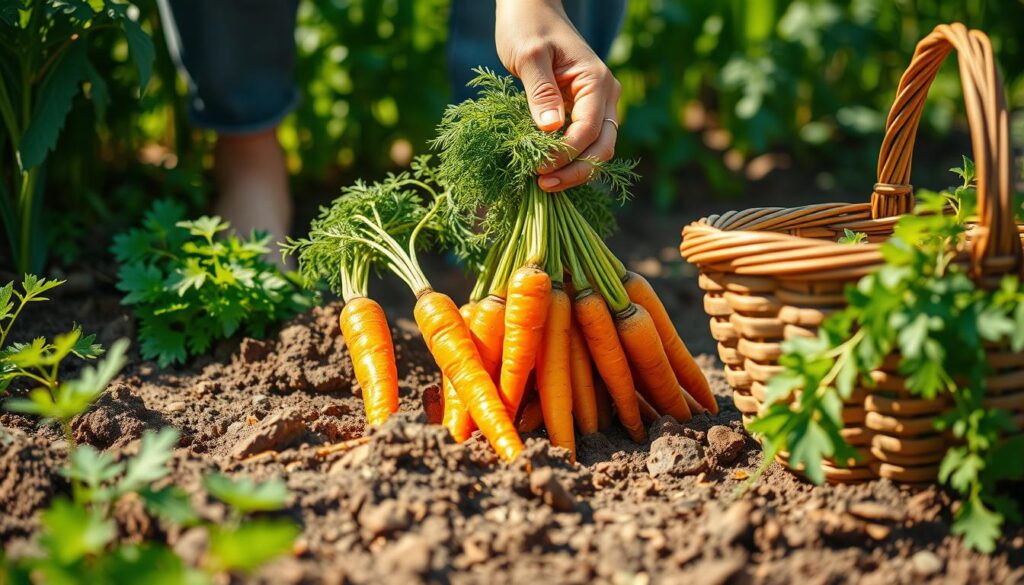
Harvest Timing Indicators
- Check the seed package or research the specific variety of carrot you’re growing to determine the average days to maturity.
- Look for a slight shoulder or crown at the top of the carrot, indicating it’s ready to be harvested.
- Gently dig around the carrot with a fork to avoid damaging the roots.
When harvesting carrots, use a garden fork and handle them carefully to avoid damage. Harvesting Carrots at the right time ensures the best flavor and texture. This makes all your Carrot Plant Care efforts worth it.
Storage and Preservation Methods
After you harvest, it’s key to store and preserve your carrots right. This keeps them fresh and good to eat. You can use the fridge, freezer, or canning to keep them fresh. For example, debsdaily has tips on setting up a rental, which can help with storage and organization.
Here are some tips for storing carrots:
- Keep them in a cool, dark place to prevent spoilage
- Use airtight containers or bags to maintain humidity
- Monitor the temperature and humidity levels to ensure optimal storage conditions
Good Carrot Care means checking for spoilage and removing bad carrots. By following these tips, you can enjoy your carrots longer.
The secret to keeping carrots quality is the right conditions. With the right storage and care, you can enjoy your carrots for months.
| Storage Method | Temperature | Humidity |
|---|---|---|
| Refrigeration | 32-40°F (0-4°C) | 80-90% |
| Freezing | 0°F (-18°C) or below | 90-100% |
| Canning | Room temperature | 60-80% |
Troubleshooting Common Growing Problems
When you grow vegetables at home, like Organic Carrot Gardening, you might face some issues. Carrots can be tricky, and problems can pop up even with good care. We’ll look at common problems and how to fix them.
Issues like slow growth, yellow leaves, and weak roots are common. These can come from bad soil, not enough water, or too hot temperatures. To fix these, keep your growing area right. This means good soil, enough water, and a cool spot.
Growth Issues
- Slow growth: Check soil quality, watering schedule, and temperature
- Yellowing leaves: Inspect for pests, diseases, or nutrient deficiencies
- Poor root development: Ensure adequate soil depth, proper thinning, and sufficient moisture
By following these tips, you can solve common problems and have a great Organic Carrot Gardening experience. Keep an eye on your plants and act fast if you see any trouble. With the right care, you can grow tasty and healthy carrots at home.
Root Development Problems
To avoid root problems, make sure your soil drains well and is loose. Keep the pH between 6.0 and 6.8. Don’t overwater, as it can cause rot. With the right care, your carrots will grow strong roots and give you a big harvest.
| Problem | Cause | Solution |
|---|---|---|
| Slow growth | Inadequate soil quality | Improve soil quality with organic amendments |
| Yellowing leaves | Pests or diseases | Inspect and treat with organic pest control methods |
| Poor root development | Insufficient moisture | Ensure consistent watering and maintain optimal soil moisture |
Conclusion: Growing Success with Your Carrot Garden
As you finish this guide, feel proud of what you’ve learned. Growing carrots is all about patience and paying attention to details. With a bit of effort, you can have a garden full of tasty carrots.
Keep an eye out for pests and diseases. And don’t be afraid to change your growing methods if needed.
There’s nothing better than picking fresh carrots from your garden. It shows the joy of gardening at home. Enjoy your successes and learn from any challenges. Share your carrots with loved ones for an extra special treat.
Happy gardening, and may your carrot patch grow abundantly!
FAQ
What are the most popular carrot varieties for home gardens?
Home gardeners often choose Nantes, Imperator, and Danver carrots. Each type has its own size, shape, color, and taste.
What are the basic growing requirements for carrots?
Carrots need well-draining, loose soil rich in organic matter. They grow best in cooler temperatures and need steady moisture, mainly when they’re germinating and growing.
How do I prepare the soil for growing carrots?
To get your soil ready for carrots, add compost or well-rotted manure. This improves the soil’s structure and fertility. Also, remove any debris, rocks, or weeds that could harm carrot growth.
What essential tools and materials do I need for growing carrots?
You’ll need basic gardening tools like a shovel, rake, and hoe. Also, get soil amendments and fertilizers, like compost or organic fertilizers. Don’t forget garden planning materials, such as a garden plan and planting calendar.
How do I properly space and plant carrot seeds?
For healthy growth, space and depth are key. Follow row spacing guidelines and thin seedlings to avoid overcrowding. Using companion planting can also help carrots grow better and fight pests and diseases.
How much water do carrots need, and what are the best watering techniques?
Carrots need steady moisture, more so when they’re germinating and growing. Avoid overwatering and underwatering. Keep the soil moist throughout the growing season.
What are the essential soil management practices for growing carrots?
For growing carrots, maintain the right pH levels and provide enough nutrients. Manage soil moisture well. Organic amendments and fertilizers help carrots grow healthily.
How do I manage common carrot pests?
Common pests like aphids, slugs, and snails can be managed with organic and integrated pest management. Keep your garden healthy and balanced to prevent pests.
How do I prevent and treat carrot diseases?
Diseases like fungal and bacterial infections can affect carrots. Prevent them by keeping your garden clean, ensuring good air circulation, and using organic disease management techniques.
What are some organic growing methods for carrots?
For organic carrots, use organic soil amendments, fertilizers, and pest management. A balanced ecosystem and biodiversity in your garden are also key for organic growth.
Can I grow carrots in containers, and what are the special care requirements?
Yes, you can grow carrots in containers. Choose the right container and provide the necessary care. Manage common challenges of growing carrots in containers.
When and how do I properly harvest carrots?
Harvest carrots when they’re the right size and mature. Check for readiness, use the right tools, and handle them gently to avoid damage.
How do I store and preserve my harvested carrots?
Store and preserve carrots by refrigerating, freezing, or canning them. Keep them in optimal conditions to maintain freshness and quality.
How do I troubleshoot common growing problems with my carrot garden?
Troubleshoot carrot growing problems like growth issues, root development, and environmental stress. Use organic and integrated management techniques. Stay observant and attentive to your garden.
Share this post: on Twitter on Facebook

